CPS proves what 'Brown v. Board of Education' saw in 1954! Segregated schools that serve the children of poverty have low test scores
Chicago Public Schools voted June 24, 2009, to continue Arne Duncan's policy of placing schools on “probation”, a move which can result in the closing of the schools and the termination of all school staff while the school becomes a candidate for what Chicago calls "turnaround" (but which is known as "reconstitution" generally in education policy). The proposed policy was presented to the Board by the system's current Chief Executive Officer, Ron Huberman, and explicated for the Board during a Power Point presentation by a staff member from the Board's Office of Research, Evaluation, and Accountability. Substance learned after the June 24 Board meeting that former Chief Officer of Research, Evaluation and Accountability Ginger Reynolds had just been fired by Huberman.
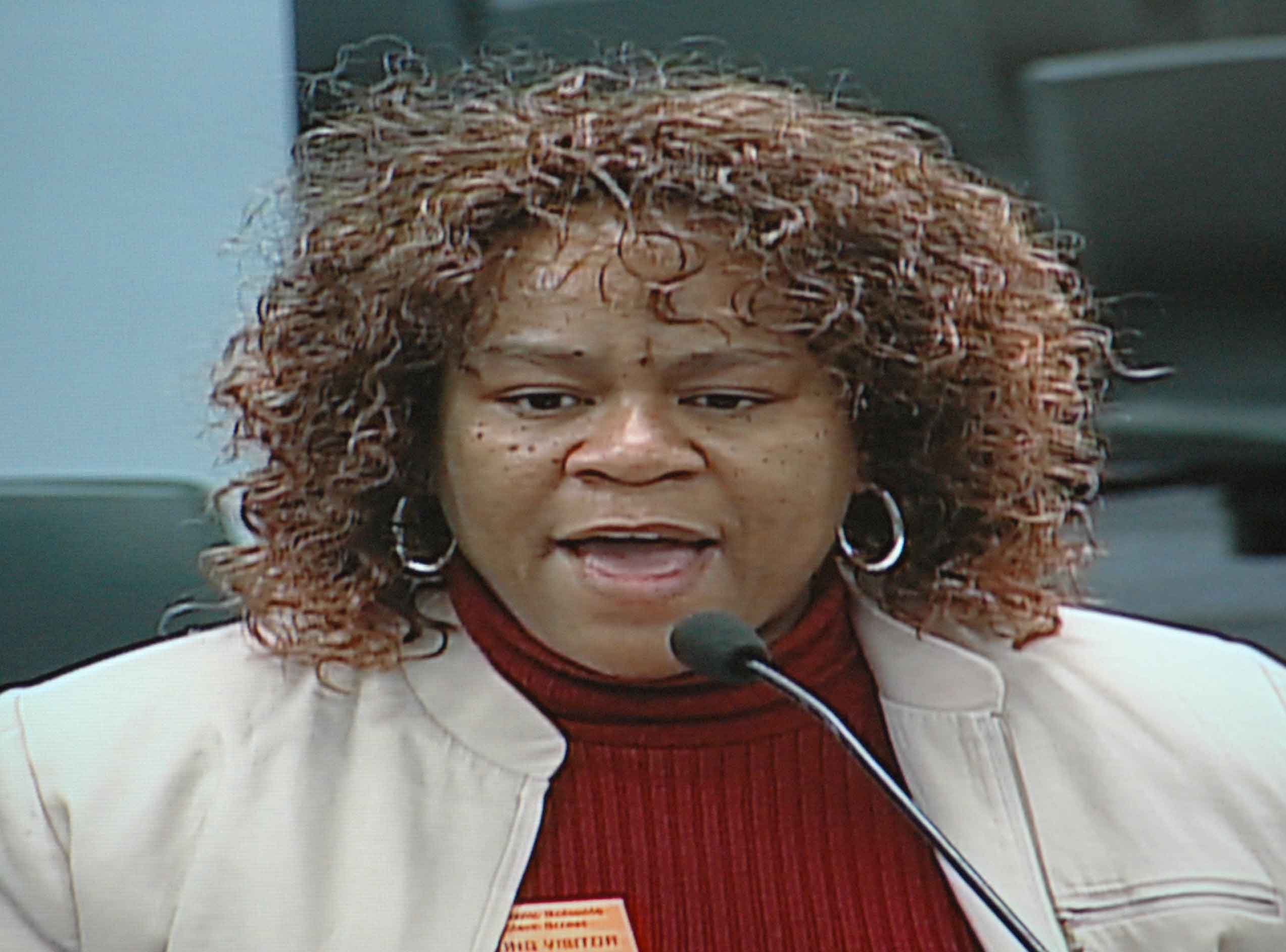 Copernicus Elementary School teacher Lois Ashford (above) was one of the teachers who spoke out in opposition to the Chicago Board of Education's proposal to subject Copernicus to "turnaround" on February 13, 2008. The "hearing" held at CPS headquarters at 125 S. Clark St. in Chicago was, as a number of parents and teachers charged, in fact a kangaroo court at which Copernicus was to be found guilty of having low test scores. Not one of the members of the Chicago Board of Education attended the hearing. Nor did then-CEO Arne Duncan attend the hearing. After the hearing, the hearing officer (a partner in the law firm that does the most outside work for CPS) recommended that Copernicus be subjected to "turnaround" (reconstitution), and Lois Ashford, along with the majority of teachers and other staff at Copernicus, were fired at the end of the 2007--2008 school year. Lois Ashford is now one of the plaintiffs in a complaint to the federal Equal Employment Opportunity Commission (EEOC) charging that "turnaround" discriminates against African American teachers. Substance photo by George N. Schmidt.With the appointment of former Chicago Public Schools Chief Executive Officer Arne Duncan as U.S. Secretary of Eduction by President Barack Obama last year, the CPS policy deserves the closest scrutiny. The policy was approved unanimously and without debate at the June 24, 2009, meeting of the Chicago Board of Education after it was presented to the Board by a mid-level official in the Board's Office of Research, Evaluation and Accountability. There were a couple of questions from Board members about the relatively "low" bar established for the city's general high schools, but no critical questions regarding the appropriateness of continuing to follow a policy which relies so heavily on standardized test scores.
Copernicus Elementary School teacher Lois Ashford (above) was one of the teachers who spoke out in opposition to the Chicago Board of Education's proposal to subject Copernicus to "turnaround" on February 13, 2008. The "hearing" held at CPS headquarters at 125 S. Clark St. in Chicago was, as a number of parents and teachers charged, in fact a kangaroo court at which Copernicus was to be found guilty of having low test scores. Not one of the members of the Chicago Board of Education attended the hearing. Nor did then-CEO Arne Duncan attend the hearing. After the hearing, the hearing officer (a partner in the law firm that does the most outside work for CPS) recommended that Copernicus be subjected to "turnaround" (reconstitution), and Lois Ashford, along with the majority of teachers and other staff at Copernicus, were fired at the end of the 2007--2008 school year. Lois Ashford is now one of the plaintiffs in a complaint to the federal Equal Employment Opportunity Commission (EEOC) charging that "turnaround" discriminates against African American teachers. Substance photo by George N. Schmidt.With the appointment of former Chicago Public Schools Chief Executive Officer Arne Duncan as U.S. Secretary of Eduction by President Barack Obama last year, the CPS policy deserves the closest scrutiny. The policy was approved unanimously and without debate at the June 24, 2009, meeting of the Chicago Board of Education after it was presented to the Board by a mid-level official in the Board's Office of Research, Evaluation and Accountability. There were a couple of questions from Board members about the relatively "low" bar established for the city's general high schools, but no critical questions regarding the appropriateness of continuing to follow a policy which relies so heavily on standardized test scores.
The complete policy can be found at the Board of Education's Web site in the "Action" Agenda for the June 24, 2009, Board meeting. The complete report is 13 pages long and is captioned Board Report 09-0624 PO1.
Policy based almost exclusively on test scores
Probationary status is based almost entirely on test scores and Chicago Public Schools' dubious implementation of the state school code.
But what does a closer look at the schools on "probation" in Chicago show?
Any school placed on probation for over a year is subject to extreme actions including the wholesale firing of all staff or closing altogether ("turnaround").
Of the schools placed on probation with no additional review, 98 percent had more students of color than the CPS average, and 99 percent had at least 3 out of 4 students designated as low-income. In contrast, of the schools designated the highest rank by the policy, only 30 percent had more students of color than the CPS average, and only 45 percent had a low-income rate of more than 3 of 4 students.
Previous probation policies under Arne Duncan
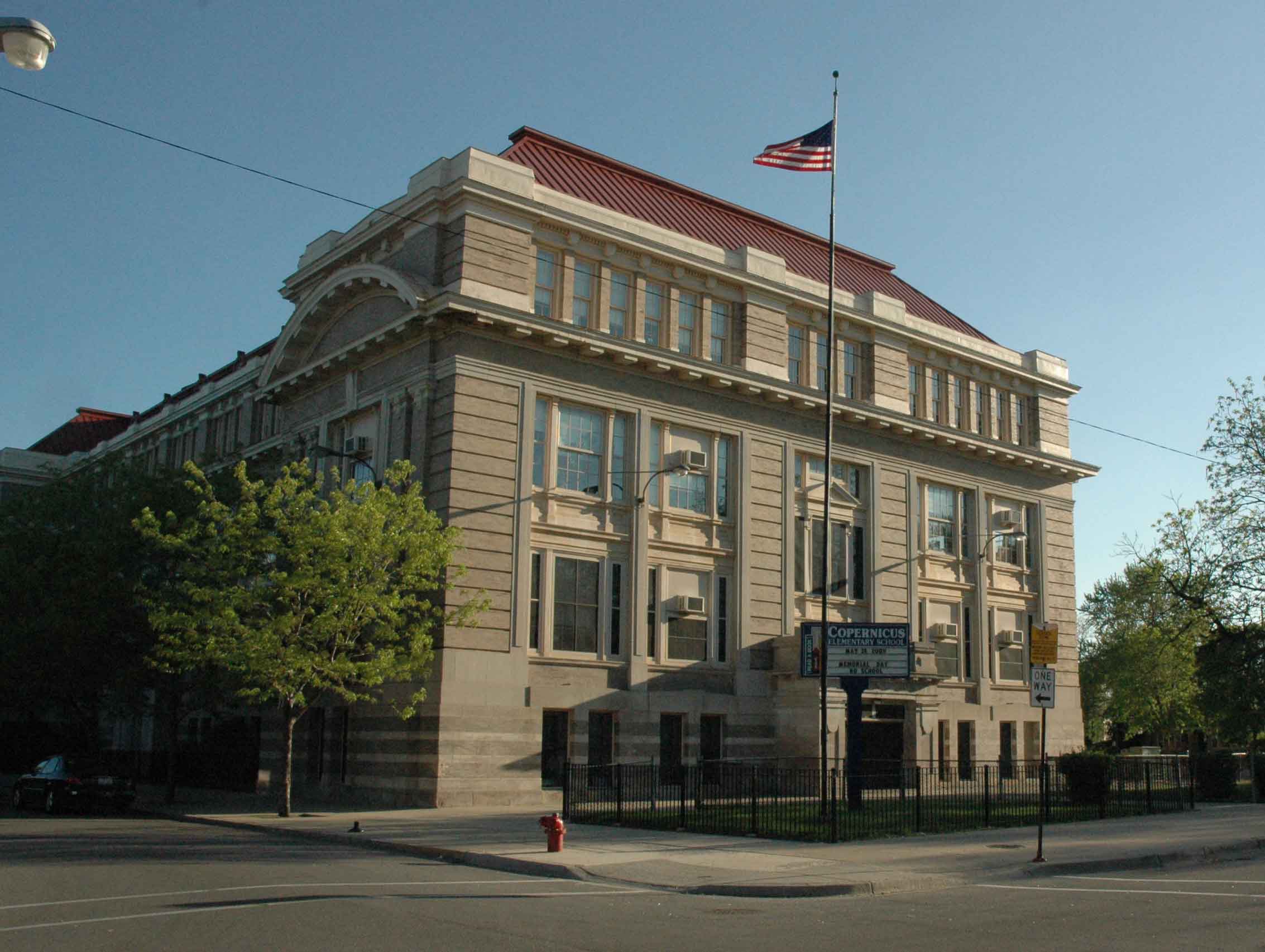 Copernicus Elementary School in Chicago (above) is located at 6010 S. Throop St. in the Englewood community. Despite years of attempts to alleviate the community's problems, the community still has one of the highest rates of poverty in the United States of America, and all of the students at Copernicus during the 2007-2008 school year came from families living below the U.S. poverty level. The majority of teachers and staff at Copernicus in May 2008, when the photo above was taken, were African American. Substance photo by George N. Schmidt.At the Chicago Board of Education meeting on December 18, 2002, then Chicago CEO Arne Duncan proposed a forerunner to the current policy. The early Duncan administration policy, which was supposed to be an improvement over the test-score-based policy of Duncan's predecessor (Paul Vallas) linked high school status to the Prairie State Achievement Examination (PSAE), and elementary school status directly to the Illinois Standards Achievement Test (ISAT) and the Iowa Test of Basis Skills (ITBS). The ITBS was subsequently dropped as the test used for Chicago's "accountability."
Copernicus Elementary School in Chicago (above) is located at 6010 S. Throop St. in the Englewood community. Despite years of attempts to alleviate the community's problems, the community still has one of the highest rates of poverty in the United States of America, and all of the students at Copernicus during the 2007-2008 school year came from families living below the U.S. poverty level. The majority of teachers and staff at Copernicus in May 2008, when the photo above was taken, were African American. Substance photo by George N. Schmidt.At the Chicago Board of Education meeting on December 18, 2002, then Chicago CEO Arne Duncan proposed a forerunner to the current policy. The early Duncan administration policy, which was supposed to be an improvement over the test-score-based policy of Duncan's predecessor (Paul Vallas) linked high school status to the Prairie State Achievement Examination (PSAE), and elementary school status directly to the Illinois Standards Achievement Test (ISAT) and the Iowa Test of Basis Skills (ITBS). The ITBS was subsequently dropped as the test used for Chicago's "accountability."
The probation policy continued to be modified throughout the next several years. On June 2, 2008, Mr. Duncan implemented the school probation policy that is analyzed in depth here. That policy also links school status to standardized test scores via a points-based system.
Performance policy and race
Of the schools placed on probation with no additional review (Level 3), 98% had more students of color than the CPS average, while only 30% of schools placed on the highest level had more students of color than the CPS average..
The School Performance, Remediation and Probation Policy places schools into Level 1 (the highest), Level 2, Level 3 Review (review for probation), or Level 3 (the lowest, automatic probation).
The resultant levels show a strong correlation to race.
Analysis of race and school performance level clearly indicates that schools serving more white students are awarded higher performance level status under the Chicago Public Schools policy. The more students of color, the more likely a school is to be put on probation. In 2009, out of 177 schools on Level 3, 148 (or 84%) served 99% or more students of color, 143 (or 81%) served 99.5% or more students of color, and 61 had no white students at all. But out of the 112 schools on Level 1, only 11 served 99% or more students of color.
Performance policy level and race
Download the Compiled Data (Excel)
Further, the median for schools designated Level 3 is 99.8% students of color (0.2% white), while the median for schools designated Level 1 is 78.5% students of color (21.5% white).
CPS placed 73% of all schools with 99.5% or more students of color into Level 3 or Level 3 Review, while 94% of all schools with more white students than the CPS average passed. And in fact, all schools with over 50% white students passed.
This analysis reinforces a Substance News analysis done in February that finds that of the 19,907 students in 42 schools listed for possible turnaround following probation, 97.7 percent are African American.
African American teachers more likely to be fired for working at 'failing schools'
The analysis here also follows in the wake of a complaint submitted by the Caucus of Rank and File Educators (CORE) to the Equal Employment Opportunity Commission stating that there are 2,000 fewer black teachers in CPS now than in 2002 — the year when turnarounds (then called "renaissance") resulting from probationary status began. In addition, a recent Catalyst Chicago analysis shows Chicago Public Schools is suspending African-American male students at twice the average rate. And a Freedom of Information Act (FOIA) response received by Parents United for Responsible Education (PURE) shows that CPS retains African-Americans at five times the rate of their white peers.
Performance policy and income
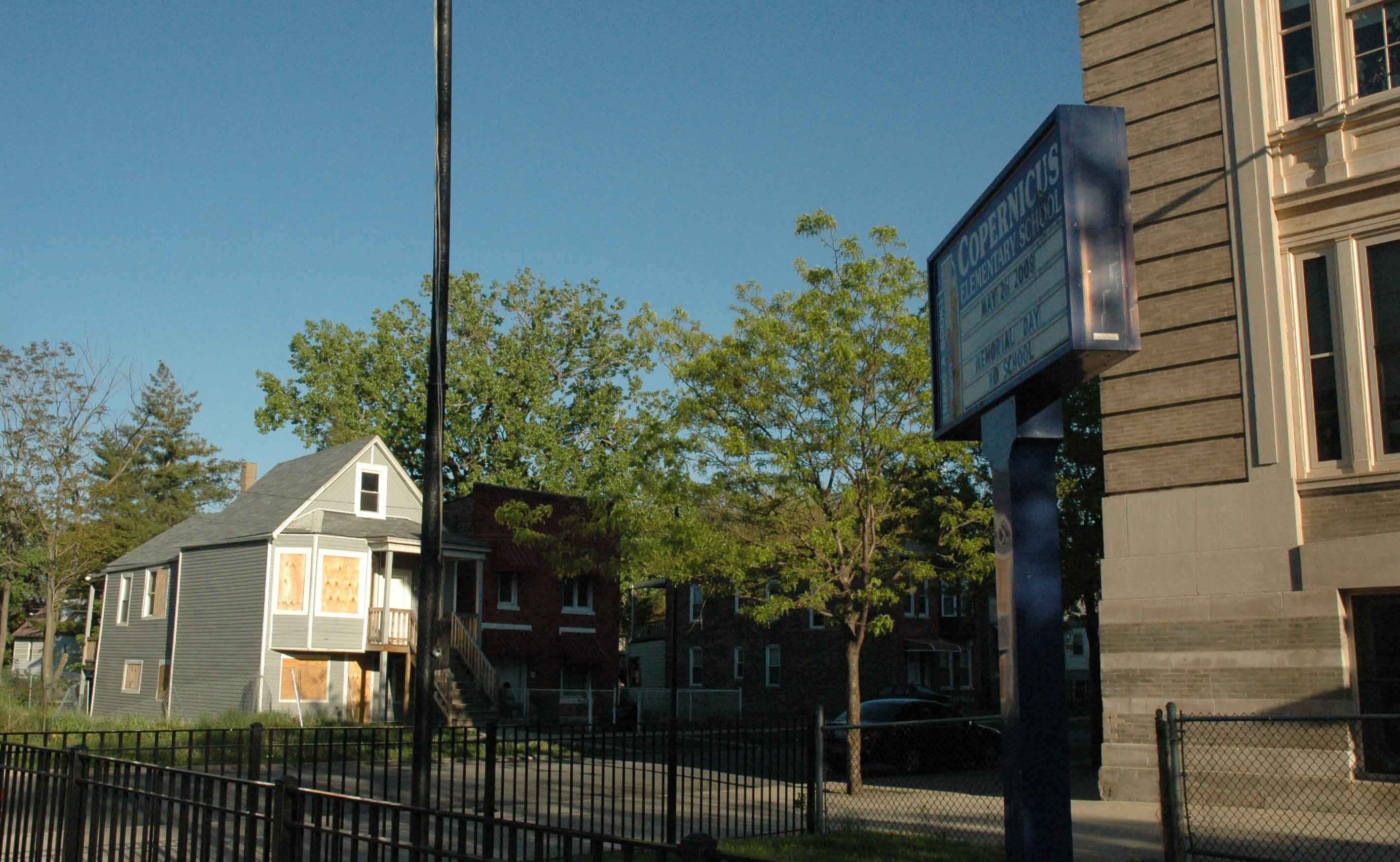 In addition to extreme segregation, Copernicus Elementary School was the victim of extreme poverty, which in Chicago oppresses the majority of communities where the city's African American people live. Above, in the background, is one of seven abandoned buildings on the four blocks adjacent to Copernicus in May 2008, when this Substance photograph was taken. Despite the evidence that complete racial segregation and heartbreaking poverty were the problems that led to low student test scores at Copernicus, the seven members of the Chicago Board of Education voted at their February 27, 2008, meeting to subject Copernicus to what Chicago began calling "turnaround." In June 2008, the majority of the teachers and other adult staff at Copernicus were fired and then Chicago CEO Arne Duncan installed a "turnaround" team to run the school. At no time during the Chicago Board of Education discussions of Copernicus did Duncan or any member of the Board acknowledge that schools like Copernicus face segregation and poverty at levels that most Americans cannot fathom. Instead, Duncan's "turnaround" policy victimizes those teachers who have devoted their lives to trying to serve the nation's poorest and most isolated African American children. Substance photo by George N. Schmidt.The analysis also found that 99 percent of schools placed on probation with no additional review had at least 3 out of 4 students designated as low-income, while only 45 percent of schools designated the highest rank by the policy had 75% or more students with low-income.
In addition to extreme segregation, Copernicus Elementary School was the victim of extreme poverty, which in Chicago oppresses the majority of communities where the city's African American people live. Above, in the background, is one of seven abandoned buildings on the four blocks adjacent to Copernicus in May 2008, when this Substance photograph was taken. Despite the evidence that complete racial segregation and heartbreaking poverty were the problems that led to low student test scores at Copernicus, the seven members of the Chicago Board of Education voted at their February 27, 2008, meeting to subject Copernicus to what Chicago began calling "turnaround." In June 2008, the majority of the teachers and other adult staff at Copernicus were fired and then Chicago CEO Arne Duncan installed a "turnaround" team to run the school. At no time during the Chicago Board of Education discussions of Copernicus did Duncan or any member of the Board acknowledge that schools like Copernicus face segregation and poverty at levels that most Americans cannot fathom. Instead, Duncan's "turnaround" policy victimizes those teachers who have devoted their lives to trying to serve the nation's poorest and most isolated African American children. Substance photo by George N. Schmidt.The analysis also found that 99 percent of schools placed on probation with no additional review had at least 3 out of 4 students designated as low-income, while only 45 percent of schools designated the highest rank by the policy had 75% or more students with low-income.
The CPS policy also results in a strong correlation between school probation status and income. The analysis clearly indicates that the schools serving less low-income students are awarded higher performance level status under the Chicago Public Schools policy.
Performance policy level and income
Comparison: Poverty vs. Probation (PDF)
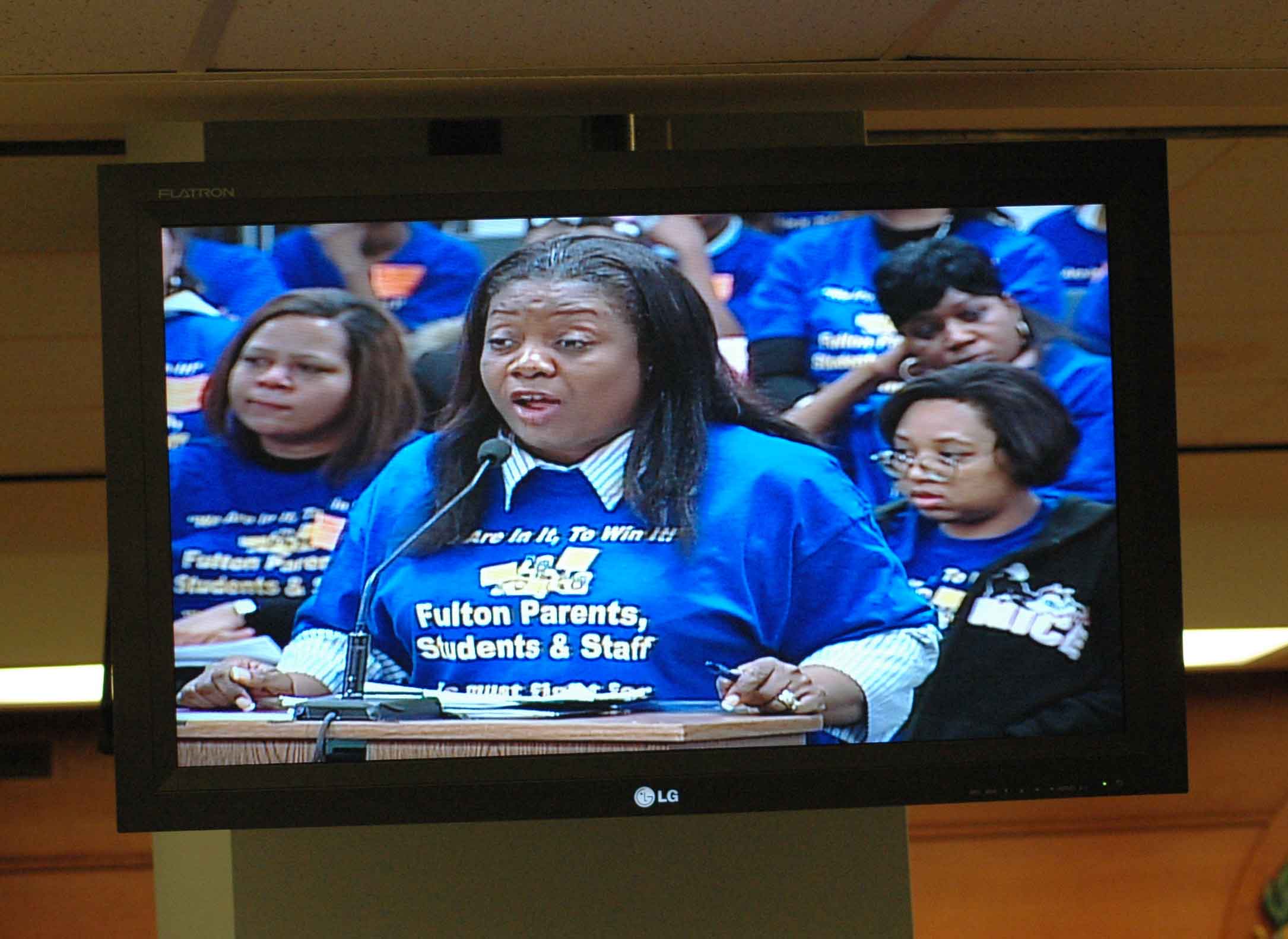 When Fulton Elementary School Principal Wardella Johnson Brookins (above, on the video monitor at CPS headquarters) told the February 11, 2008, hearing on the proposed turnaround of the school that Fulton had been improving during the short time she had been principal, the large turnout of teachers, parents, and students — all wearing blue Fulton tee shirts — brought hundreds of pages of petitions and other materials to prove the case that she was making. Not one of the seven members of the Chicago Board of Education, nor then-CEO Arne Duncan, attended the hearings. When the Board members voted to subject the school to "turnaround" (and ultimately, fire virtually all of its teachers) at its February 27, 2008 meeting, not one of the Board members had bothered to read the complete record, including student appeals and parent petitions, that had been painstakingly assembled by the people of Fulton. Most of Fulton's veteran teachers who were purged during the "turnaround" are still without full-time positions in Chicago, many after having decided to remain in the challenging Englewood community for the sake of the children. Except for a large infusion of hype, the "new Fulton" is still among Chicago's "lowest performing" elementary schools. The reason, as the Fulton staff, parents, and children pointed out, is that life outside the walls of Fulton elementary school is challenging because of poverty, gang crime, unemployment, drugs, and the heart breaking results of the most segregated city in the USA. Substance photo by George N. Schmidt. Schools designated Level 3 had a median low-income rate of 96 percent, while schools designated Level 1 had a median low-income rate of 67%. All schools with less a low-income rate of less than 55 percent of the student population were safe from being put on probation.
When Fulton Elementary School Principal Wardella Johnson Brookins (above, on the video monitor at CPS headquarters) told the February 11, 2008, hearing on the proposed turnaround of the school that Fulton had been improving during the short time she had been principal, the large turnout of teachers, parents, and students — all wearing blue Fulton tee shirts — brought hundreds of pages of petitions and other materials to prove the case that she was making. Not one of the seven members of the Chicago Board of Education, nor then-CEO Arne Duncan, attended the hearings. When the Board members voted to subject the school to "turnaround" (and ultimately, fire virtually all of its teachers) at its February 27, 2008 meeting, not one of the Board members had bothered to read the complete record, including student appeals and parent petitions, that had been painstakingly assembled by the people of Fulton. Most of Fulton's veteran teachers who were purged during the "turnaround" are still without full-time positions in Chicago, many after having decided to remain in the challenging Englewood community for the sake of the children. Except for a large infusion of hype, the "new Fulton" is still among Chicago's "lowest performing" elementary schools. The reason, as the Fulton staff, parents, and children pointed out, is that life outside the walls of Fulton elementary school is challenging because of poverty, gang crime, unemployment, drugs, and the heart breaking results of the most segregated city in the USA. Substance photo by George N. Schmidt. Schools designated Level 3 had a median low-income rate of 96 percent, while schools designated Level 1 had a median low-income rate of 67%. All schools with less a low-income rate of less than 55 percent of the student population were safe from being put on probation.
These findings are not entirely surprising, as numerous studies indicate a correlation between income level and test scores, and CPS uses mainly test scores to determine the performance level.
CPS Policy and the Illinois School Code
Apparently, CPS claims authority to implement it's school performance, remediation, and probation policy under the authority given to them by the state (105 ILCS 5/34-8.3 (a)) if
"(2) there is a pervasive breakdown in the educational program as indicated by factors, including, but not limited to, the absence of improvement in student reading and math achievement scores, an increased drop out rate, a decreased graduation rate, and a decrease in rate of student attendance..."
But, in fact, CPS performance policy does not monitor increased drop-out rates or decreased graduation and attendance rates at all.
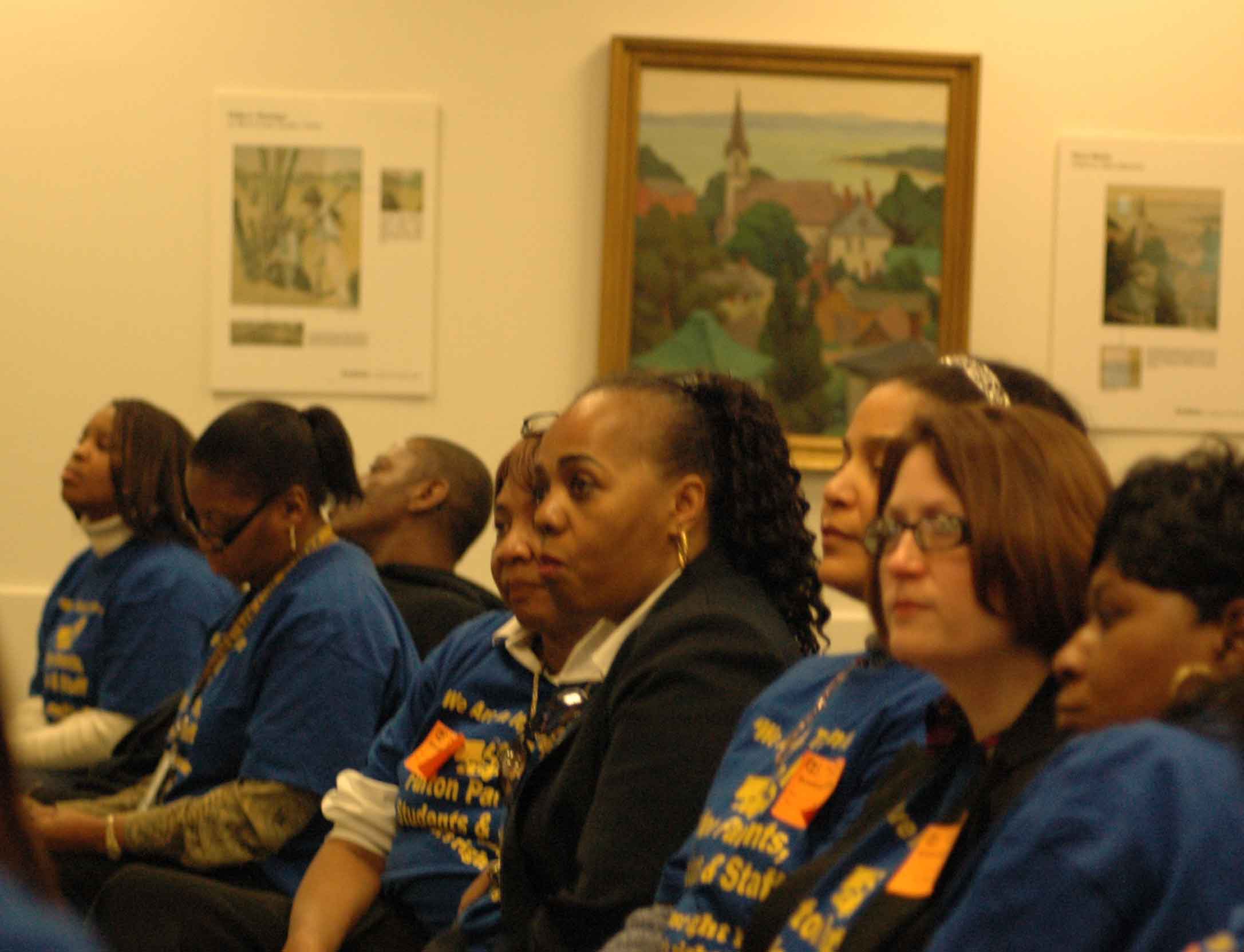 After nearly 50 years of complete segregation caused by the policies of two "Daley" administrations (Richard J. Daley was mayor of Chicago from 1956 to 1976, Richard M. Daley has been mayor of Chicago since 1988), the students at Fulton were segregated and minority. The staff, most of them veteran teachers, were also mostly African American (women). On orders of Mayor Daley, during his term as Chief Executive Officer, Arne Duncan (CEO, 2001 - 2008) had stopped the publication of the annual "Racial Ethnic Survey of Staff" that had been produced continuously for 40 years, thereby making it more difficult for researchers to demonstrate the impact of "turnaround" on African American teachers (who are being fired and replaced by younger white teachers at most "turnaround" schools). The teachers and parents above were attending the hearing on the proposed "turnaround" of Fulton Elementary School on February 11, 2008, when most of them spoke in opposition to Duncan's plan, citing both the progress of the school and the heart breaking facts about the challenges faced by the school's families and children in the heart of one of the most dangerous communities in the nation's most segregated city, Chicago. Substance photo by George N. Schmidt.And a school holding steady on any factors described by the state will get no performance points whatsoever. This is in apparent contradiction to the intent of the code, which was written to only punish schools getting worse in these categories. CPS policy, on the other hand, punishes schools for not making extreme gains.
After nearly 50 years of complete segregation caused by the policies of two "Daley" administrations (Richard J. Daley was mayor of Chicago from 1956 to 1976, Richard M. Daley has been mayor of Chicago since 1988), the students at Fulton were segregated and minority. The staff, most of them veteran teachers, were also mostly African American (women). On orders of Mayor Daley, during his term as Chief Executive Officer, Arne Duncan (CEO, 2001 - 2008) had stopped the publication of the annual "Racial Ethnic Survey of Staff" that had been produced continuously for 40 years, thereby making it more difficult for researchers to demonstrate the impact of "turnaround" on African American teachers (who are being fired and replaced by younger white teachers at most "turnaround" schools). The teachers and parents above were attending the hearing on the proposed "turnaround" of Fulton Elementary School on February 11, 2008, when most of them spoke in opposition to Duncan's plan, citing both the progress of the school and the heart breaking facts about the challenges faced by the school's families and children in the heart of one of the most dangerous communities in the nation's most segregated city, Chicago. Substance photo by George N. Schmidt.And a school holding steady on any factors described by the state will get no performance points whatsoever. This is in apparent contradiction to the intent of the code, which was written to only punish schools getting worse in these categories. CPS policy, on the other hand, punishes schools for not making extreme gains.
In the area of test scores, CPS policy also oversteps the intent of the state law by awarding points based on the amount of the gains, rather than simply the “absence of improvement”. To earn significant points towards not being automatically put on probation, a school has to make quite amazing improvements in test scores. For example, consider a hypothetical elementary school making a consistent one point gain for four straight years in all categories for which CPS awards points. [See graphic.] This school, despite making clear gains, would be put on probation by CPS.
The June 24, 2009, Chicago Board of Education vote
As of Wednesday, June 24, 2009, CPS would override all of the above factors for any school scoring below a cut score (50% composite meeting or exceeding on the ISATs, or any high school scoring below 10% composite meeting or exceeding on the PSAE).
In that case, CPS would unceremoniously plop the school into probationary status without review, regardless of any gains, amazing or not.
Again, CPS seems to clearly overstep the original intent of the school code which spoke of “the absence of improvement”. CPS admitted during the June 24th presentation to the board that the implementation of this cut score will put additional schools on probation. CPS personnel Ryan Crosby (of the research and evaluation department), Monique Bond (communications), and Malon Edwards (communications) were reached but did not disclose the names of the schools affected. Based on 2008 test scores, the elementary schools that would be bumped down to Level 3 from Level 3 Review are Faraday (49.9), Ryerson (49.7), Jackson, M. (48.7), Medill (42.6), and Harvard (40.1).
After conducting the review mentioned in the Illinois school code, CPS does not have to place a school on probation, instead it could opt for remediation, which could include writing a new school improvement plan or “mediating disputes or other obstacles to reform”. But if the general superintendent (or presumably, the CEO) wants to, he can jump right to probation. In Chicago,of the 548 schools given 2009 promotion status, 248 of them were designated Level 3, while an additional 43 are marked for Level 3 review. CPS is failing 45% of its own schools, and has an additional 8% in limbo. That adds up to 150,000 students.
Thus, CPS is making half of its schools subject to the dreaded 105 ILCS 5/34-8.3:
(d) Schools placed on probation that, after a maximum of one year, fail to make adequate progress in correcting deficiencies are subject to the following action by the general superintendent with the approval of the board, after opportunity for a hearing: (1) Ordering new local school council elections. (2) Removing and replacing the principal. (3) Replacement of faculty members, subject to the provisions of Section 24A 5. (4) Reconstitution of the attendance center and replacement and reassignment by the general superintendent of all employees of the attendance center. (5) Intervention under Section 34 8.4. (Turnaround – principal directed) (6) Closing of the school.
Charters Exempt
While CPS is comfortable putting it's neighborhood public schools on probation based on the results of a spread sheet, charter schools receive different treatment.
CPS exempts charter schools from the performance, remediation and probation policy. Instead, a “decision to renew or revoke a school's charter is governed by the terms of a school's applicable performance agreement and accountability plan with the Board.”
Chicago Public Schools Policy and National Policy
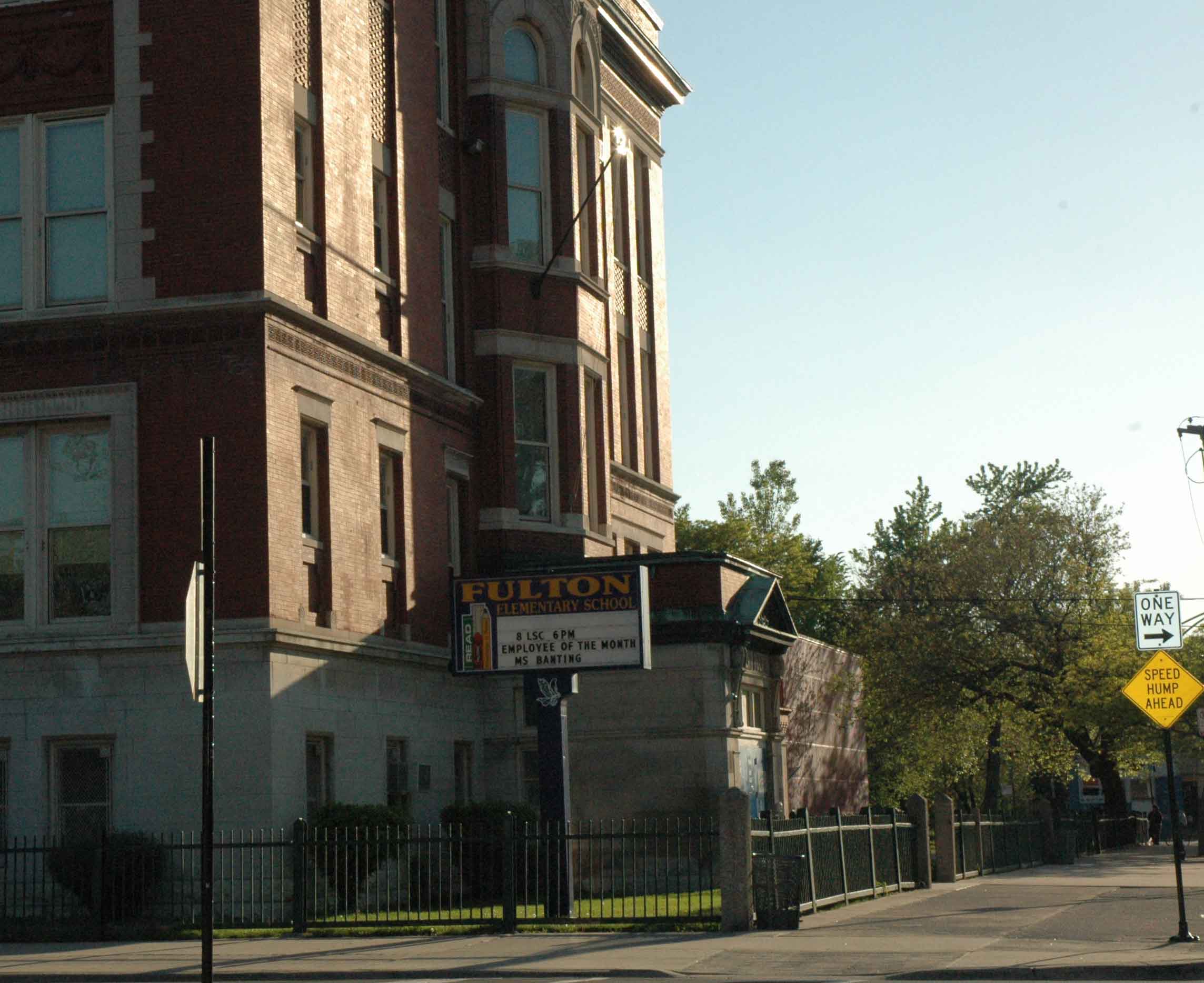 One of the teachers from Fulton Elementary School (above, located at 5300 S. Hermitage Ave. in Chicago) told Substance off the record at the time of the February 2008 hearings on Arne Duncan's proposal to "turnaround" Fulton that not one of the members of the Chicago Board of Education would stay in the school's community after dark without a police guard. Despite the evidence, presented carefully by Fulton parents, teachers, principal, children, and community supporters, that Fulton's problems stemmed from the combination of complete racial segregation and poverty facing the schools children, Arne Duncan publicly denounced the school as a "failure" and promoted the "turnaround" policy that he is now trying to force on every state in the USA. Instead of correcting the root social and economic causes outside the doors of the public school in Chicago where students score "low" on standardized tests, Duncan and his corporate supporters (including the members of the Chicago Board of Education) simply blame teachers and principals for the so-called "gap" in test scores between African American children and the more affluent children at schools in more affluent communities. Substance photo taken in May 2008 by George N. Schmidt.Since these are the results of a policy enacted in Chicago under the leadership of Mr. Duncan before he went on to become the Secretary of Education, it is worth asking whether the demographics will be similar for the 5,000 nationwide schools that Mr. Duncan and the Obama administration have proposed to turnaround in the next five years. Whose schools are getting turned around and why?
One of the teachers from Fulton Elementary School (above, located at 5300 S. Hermitage Ave. in Chicago) told Substance off the record at the time of the February 2008 hearings on Arne Duncan's proposal to "turnaround" Fulton that not one of the members of the Chicago Board of Education would stay in the school's community after dark without a police guard. Despite the evidence, presented carefully by Fulton parents, teachers, principal, children, and community supporters, that Fulton's problems stemmed from the combination of complete racial segregation and poverty facing the schools children, Arne Duncan publicly denounced the school as a "failure" and promoted the "turnaround" policy that he is now trying to force on every state in the USA. Instead of correcting the root social and economic causes outside the doors of the public school in Chicago where students score "low" on standardized tests, Duncan and his corporate supporters (including the members of the Chicago Board of Education) simply blame teachers and principals for the so-called "gap" in test scores between African American children and the more affluent children at schools in more affluent communities. Substance photo taken in May 2008 by George N. Schmidt.Since these are the results of a policy enacted in Chicago under the leadership of Mr. Duncan before he went on to become the Secretary of Education, it is worth asking whether the demographics will be similar for the 5,000 nationwide schools that Mr. Duncan and the Obama administration have proposed to turnaround in the next five years. Whose schools are getting turned around and why?
What studies have been done and what efforts have been made by Mr. Duncan or the Chicago Public Schools to avoid the disproportionate effect of the school probation policy on schools that serve minority communities?
Does this turnaround policy unfairly punish schools and staff who serve low-income students of color? Is a policy that consistently tells predominantly minority students and their teachers they are failures the best way to encourage a passion for education? What lesson will students of color take from this approach? What efforts have been made to find the positive assets in each community and build on those? Do test scores determine whether an educational environment is relevant and empowering to a student's life, present and future? What degree of participation and democracy have been used to determine if a school is successful?
In the upcoming months, questions such as these will be in the air not just in the Windy City, but in cities and towns across the USA.


By: Racist Policies
Daley family lies
Look at the policies of Mayor Daley and those appointed by him to systematically destroy African-American committees. Between him and his father (21 + 20) they have ruled Chicago for an entire generation and calculated corrected over time controlled three generations of Chicago citizens with their policies. As can clearly be seen the African American communities are still segregated and are continuously targeted as places of failure and probation.
There is no one else to blame except the Daley family for the racist policies in Chicago that have resulted in a large number children of color and lower SES unable to do compete with calculations when they graduate high school.
The findings were part of a report by the National Center for Education Statistics that examined racial achievement gaps for math and reading across the country.http://nces.ed.gov/nationsreportcard/studies/gaps/
This is a fact.
By the way being gay, hispanic or black does not mean you are not a racist. When people are trained to systematically discriminate and divert services from one group of people they are racists.
Remember who has been in power and who is in control.
The policy maker in Chicago will spin the story how ever-way they want. They will say the sky is purple and will have thousand saying yes it is purple when in fact it is blue.
Remember who has been in power and who is in control. for over 40 years now.
Remember the facts, not what people write as the facts. Also remember the Daley family lies(father "shoot to kill" Daley jr "Olympic funding")
History lesson about governmental deception
http://en.wikipedia.org/wiki/Richard_J._Daley
Daley was castigated by many for his sharp rhetoric in the aftermath of rioting that took place after Martin Luther King, Jr.'s assassination. Displeased with what he saw as an overly cautious police response to the rioting, Daley chastised police superintendent James B. Conlisk and subsequently related that conversation at a City Hall press conference as follows[2]:
"I said to him very emphatically and very definitely that an order be issued by him immediately to shoot to kill any arsonist or anyone with a Molotov cocktail in his hand, because they're potential murderers, and to shoot to maim or cripple anyone looting."
.....Rev. Jesse Jackson, for example, called it "a fascist's response." The Mayor later backed away from his words in an address to the City Council, saying:
"It is the established policy of the police department – fully supported by this administration – that only the minimum force necessary be used by policemen in carrying out their duties."
Later that month, Daley asserted "There wasn't any shoot-to-kill order. That was a fabrication."